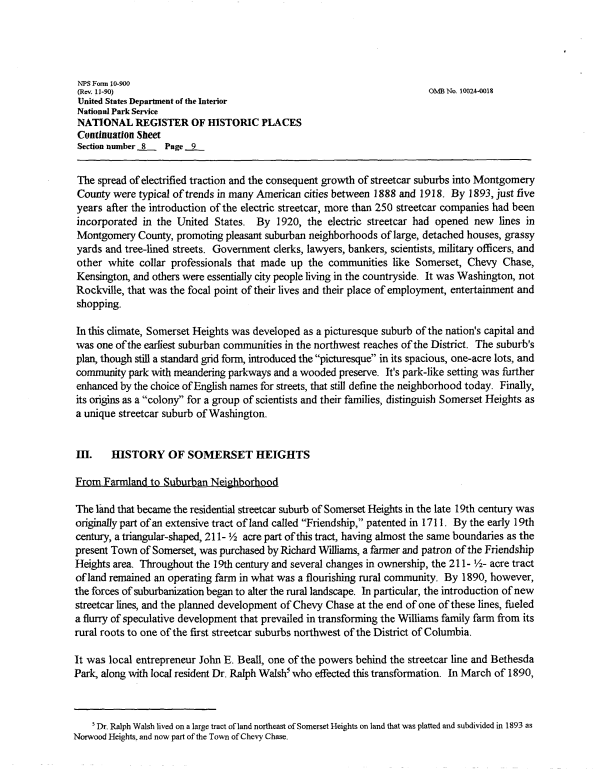 |
||||
|
DEPARTMENT OF HOUSING AND COMMUNITY DEVELOPMENT, MARYLAND HISTORICAL TRUST (Historic Sites Survey) var.d. MSA SE16-5 Image No: se16-5-0235 Enlarge and print image (75K) |
 |
||||
|
DEPARTMENT OF HOUSING AND COMMUNITY DEVELOPMENT, MARYLAND HISTORICAL TRUST (Historic Sites Survey) var.d. MSA SE16-5 Image No: se16-5-0235 Enlarge and print image (75K) |
| NFS Form 10-900 (Rev. 11-90) OMB No. 10024-0018 United States Department of the Interior National Park Service NATIONAL REGISTER OF HISTORIC PLACES Continuation Sheet Section number _8_ Page 9 The spread of electrified traction and the consequent growth of streetcar suburbs into Montgomery County were typical of trends in many American cities between 1888 and 1918. By 1893, just five years after the introduction of the electric streetcar, more than 250 streetcar companies had been incorporated in the United States. By 1920, the electric streetcar had opened new lines in Montgomery County, promoting pleasant suburban neighborhoods of large, detached houses, grassy yards and tree-lined streets. Government clerks, lawyers, bankers, scientists, military officers, and other white collar professionals that made up the communities like Somerset, Chevy Chase, Kensington, and others were essentially city people living in the countryside. It was Washington, not Rockville, that was the focal point of their lives and their place of employment, entertainment and shopping. In this climate, Somerset Heights was developed as a picturesque suburb of the nation's capital and was one of the earliest suburban communities in the northwest reaches of the District. The suburb's plan, though still a standard grid form, introduced the "picturesque" in its spacious, one-acre lots, and community park with meandering parkways and a wooded preserve. It's park-like setting was further enhanced by the choice of English names for streets, that still define the neighborhood today. Finally, its origins as a "colony" for a group of scientists and their families, distinguish Somerset Heights as a unique streetcar suburb of Washington. ffl. HISTORY OF SOMERSET HEIGHTS From Farmland to Suburban Neighborhood The land that became the residential streetcar suburb of Somerset Heights in the late 19th century was originally part of an extensive tract of land called "Friendship," patented in 1711. By the early 19th century, a triangular-shaped, 211- Vz acre part of this tract, having almost the same boundaries as the present Town of Somerset, was purchased by Richard Williams, a farmer and patron of the Friendship Heights area. Throughout the 19th century and several changes in ownership, the 211- Vz- acre tract of land remained an operating farm in what was a flourishing rural community. By 1890, however, the forces of suburbanization began to alter the rural landscape. In particular, the introduction of new streetcar lines, and the planned development of Chevy Chase at the end of one of these lines, fueled a flurry of speculative development that prevailed in transforming the Williams family farm from its rural roots to one of the first streetcar suburbs northwest of the District of Columbia. It was local entrepreneur John E. Beall, one of the powers behind the streetcar line and Bethesda Park, along with local resident Dr. Ralph Walsh5 who effected this transformation. In March of 1890, 5 Dr. Ralph Walsh lived on a large tract of land northeast of Somerset Heights on land that was platted and subdivided in 1893 as Norwood Heights, and now part of the Town of Chevy Chase. |